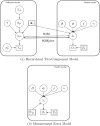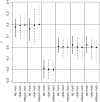A hierarchical modelling approach to assess multi pollutant effects in time-series studies
- PMID: 30830920
- PMCID: PMC6398830
- DOI: 10.1371/journal.pone.0212565
A hierarchical modelling approach to assess multi pollutant effects in time-series studies
Abstract
When assessing the short-term effect of air pollution on health outcomes, it is common practice to consider one pollutant at a time, due to their high correlation. Multi pollutant methods have been recently proposed, mainly consisting of collapsing the different pollutants into air quality indexes or clustering the pollutants and then evaluating the effect of each cluster on the health outcome. A major drawback of such approaches is that it is not possible to evaluate the health impact of each pollutant. In this paper we propose the use of the Bayesian hierarchical framework to deal with multi pollutant concentrations in a two-component model: a pollutant model is specified to estimate the 'true' concentration values for each pollutant and then such concentration is linked to the health outcomes in a time-series perspective. Through a simulation study we evaluate the model performance and we apply the modelling framework to investigate the effect of six pollutants on cardiovascular mortality in Greater London in 2011-2012.
Conflict of interest statement
The authors have declared that no competing interests exist.
Figures



